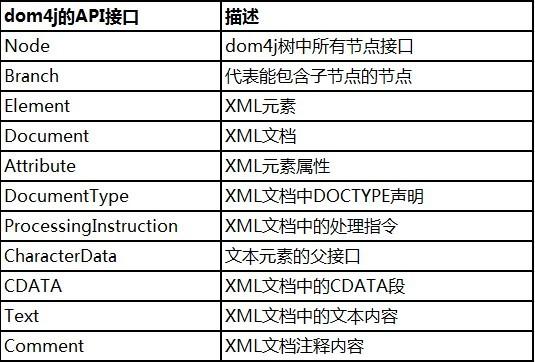与利用DOM、SAX、JAXP机制来解析xml相比,DOM4J 表现更优秀,具有性能优异、功能强大和极端易用使用的特点,只要懂得DOM基本概念,就可以通过dom4j的api文档来解析xml。dom4j是一套开源的api。实际项目中,往往选择dom4j来作为解析xml的利器。
先来看看dom4j中对应XML的DOM树建立的继承关系:

针对于XML标准定义,对应于图2-1列出的内容,dom4j提供了以下实现:

同时,dom4j的NodeType枚举实现了XML规范中定义的node类型。如此可以在遍历xml文档的时候通过常量来判断节点类型了。
常用API
class org.dom4j.io.SAXReader
read 提供多种读取xml文件的方式,返回一个Domcument对象
interface org.dom4j.Document
iterator 使用此法获取node
getRootElement 获取根节点
interface org.dom4j.Node
getName 获取node名字,例如获取根节点名称为bookstore
getNodeType 获取node类型常量值,例如获取到bookstore类型为1——Element
getNodeTypeName 获取node类型名称,例如获取到的bookstore类型名称为Element
interface org.dom4j.Element
attributes 返回该元素的属性列表
attributeValue 根据传入的属性名获取属性值
elementIterator 返回包含子元素的迭代器
elements 返回包含子元素的列表
interface org.dom4j.Attribute
getName 获取属性名
getValue 获取属性值
interface org.dom4j.Text
getText 获取Text节点值
interface org.dom4j.CDATA
getText 获取CDATA Section值
interface org.dom4j.Comment
getText 获取注释
实例一:
//先加入dom4j.jar包
import java.util.HashMap;
import java.util.Iterator;
import java.util.Map;
import org.dom4j.Document;
import org.dom4j.DocumentException;
import org.dom4j.DocumentHelper;
import org.dom4j.Element;
/**
* @Title: TestDom4j.java
* @Package
* @Description: 解析xml字符串
* @author 无处不在
* @date 2012-11-20 下午05:14:05
* @version V1.0
*/
public class TestDom4j {
public void readStringXml(String xml) {
Document doc = null;
try {
// 读取并解析XML文档
// SAXReader就是一个管道,用一个流的方式,把xml文件读出来
//
// SAXReader reader = new SAXReader(); //User.hbm.xml表示你要解析的xml文档
// Document document = reader.read(new File("User.hbm.xml"));
// 下面的是通过解析xml字符串的
doc = DocumentHelper.parseText(xml); // 将字符串转为XML
Element rootElt = doc.getRootElement(); // 获取根节点
System.out.println("根节点:" + rootElt.getName()); // 拿到根节点的名称
Iterator iter = rootElt.elementIterator("head"); // 获取根节点下的子节点head
// 遍历head节点
while (iter.hasNext()) {
Element recordEle = (Element) iter.next();
String title = recordEle.elementTextTrim("title"); // 拿到head节点下的子节点title值
System.out.println("title:" + title);
Iterator iters = recordEle.elementIterator("script"); // 获取子节点head下的子节点script
// 遍历Header节点下的Response节点
while (iters.hasNext()) {
Element itemEle = (Element) iters.next();
String username = itemEle.elementTextTrim("username"); // 拿到head下的子节点script下的字节点username的值
String password = itemEle.elementTextTrim("password");
System.out.println("username:" + username);
System.out.println("password:" + password);
}
}
Iterator iterss = rootElt.elementIterator("body"); ///获取根节点下的子节点body
// 遍历body节点
while (iterss.hasNext()) {
Element recordEless = (Element) iterss.next();
String result = recordEless.elementTextTrim("result"); // 拿到body节点下的子节点result值
System.out.println("result:" + result);
Iterator itersElIterator = recordEless.elementIterator("form"); // 获取子节点body下的子节点form
// 遍历Header节点下的Response节点
while (itersElIterator.hasNext()) {
Element itemEle = (Element) itersElIterator.next();
String banlce = itemEle.elementTextTrim("banlce"); // 拿到body下的子节点form下的字节点banlce的值
String subID = itemEle.elementTextTrim("subID");
System.out.println("banlce:" + banlce);
System.out.println("subID:" + subID);
}
}
} catch (DocumentException e) {
e.printStackTrace();
} catch (Exception e) {
e.printStackTrace();
}
}
/**
* @description 将xml字符串转换成map
* @param xml
* @return Map
*/
public static Map readStringXmlOut(String xml) {
Map map = new HashMap();
Document doc = null;
try {
// 将字符串转为XML
doc = DocumentHelper.parseText(xml);
// 获取根节点
Element rootElt = doc.getRootElement();
// 拿到根节点的名称
System.out.println("根节点:" + rootElt.getName());
// 获取根节点下的子节点head
Iterator iter = rootElt.elementIterator("head");
// 遍历head节点
while (iter.hasNext()) {
Element recordEle = (Element) iter.next();
// 拿到head节点下的子节点title值
String title = recordEle.elementTextTrim("title");
System.out.println("title:" + title);
map.put("title", title);
// 获取子节点head下的子节点script
Iterator iters = recordEle.elementIterator("script");
// 遍历Header节点下的Response节点
while (iters.hasNext()) {
Element itemEle = (Element) iters.next();
// 拿到head下的子节点script下的字节点username的值
String username = itemEle.elementTextTrim("username");
String password = itemEle.elementTextTrim("password");
System.out.println("username:" + username);
System.out.println("password:" + password);
map.put("username", username);
map.put("password", password);
}
}
//获取根节点下的子节点body
Iterator iterss = rootElt.elementIterator("body");
// 遍历body节点
while (iterss.hasNext()) {
Element recordEless = (Element) iterss.next();
// 拿到body节点下的子节点result值
String result = recordEless.elementTextTrim("result");
System.out.println("result:" + result);
// 获取子节点body下的子节点form
Iterator itersElIterator = recordEless.elementIterator("form");
// 遍历Header节点下的Response节点
while (itersElIterator.hasNext()) {
Element itemEle = (Element) itersElIterator.next();
// 拿到body下的子节点form下的字节点banlce的值
String banlce = itemEle.elementTextTrim("banlce");
String subID = itemEle.elementTextTrim("subID");
System.out.println("banlce:" + banlce);
System.out.println("subID:" + subID);
map.put("result", result);
map.put("banlce", banlce);
map.put("subID", subID);
}
}
} catch (DocumentException e) {
e.printStackTrace();
} catch (Exception e) {
e.printStackTrace();
}
return map;
}
public static void main(String[] args) {
// 下面是需要解析的xml字符串例子
String xmlString = "<html>" + "<head>" + "<title>dom4j解析一个例子</title>"
+ "<script>" + "<username>yangrong</username>"
+ "<password>123456</password>" + "</script>" + "</head>"
+ "<body>" + "<result>0</result>" + "<form>"
+ "<banlce>1000</banlce>" + "<subID>36242519880716</subID>"
+ "</form>" + "</body>" + "</html>";
/*
* Test2 test = new Test2(); test.readStringXml(xmlString);
*/
Map map = readStringXmlOut(xmlString);
Iterator iters = map.keySet().iterator();
while (iters.hasNext()) {
String key = iters.next().toString(); // 拿到键
String val = map.get(key).toString(); // 拿到值
System.out.println(key + "=" + val);
}
}
}实例二:
/**
* 解析包含有DB连接信息的XML文件
* 格式必须符合如下规范:
* 1. 最多三级,每级的node名称自定义;
* 2. 二级节点支持节点属性,属性将被视作子节点;
* 3. CDATA必须包含在节点中,不能单独出现。
*
* 示例1——三级显示:
* <db-connections>
* <connection>
* <name>DBTest</name>
* <jndi></jndi>
* <url>
* <![CDATA[jdbc:mysql://localhost:3306/db_test?useUnicode=true&characterEncoding=UTF8]]>
* </url>
* <driver>org.gjt.mm.mysql.Driver</driver>
* <user>test</user>
* <password>test2012</password>
* <max-active>10</max-active>
* <max-idle>10</max-idle>
* <min-idle>2</min-idle>
* <max-wait>10</max-wait>
* <validation-query>SELECT 1+1</validation-query>
* </connection>
* </db-connections>
*
* 示例2——节点属性:
* <bookstore>
* <book category="cooking">
* <title lang="en">Everyday Italian</title>
* <author>Giada De Laurentiis</author>
* <year>2005</year>
* <price>30.00</price>
* </book>
*
* <book category="children" title="Harry Potter" author="J K. Rowling" year="2005" price="$29.9"/>
* </bookstore>
*
* @param configFile
* @return
* @throws Exception
*/
public static List<Map<String, String>> parseDBXML(String configFile) throws Exception {
List<Map<String, String>> dbConnections = new ArrayList<Map<String, String>>();
InputStream is = Parser.class.getResourceAsStream(configFile);
SAXReader saxReader = new SAXReader();
Document document = saxReader.read(is);
Element connections = document.getRootElement();
Iterator<Element> rootIter = connections.elementIterator();
while (rootIter.hasNext()) {
Element connection = rootIter.next();
Iterator<Element> childIter = connection.elementIterator();
Map<String, String> connectionInfo = new HashMap<String, String>();
List<Attribute> attributes = connection.attributes();
for (int i = 0; i < attributes.size(); ++i) { // 添加节点属性
connectionInfo.put(attributes.get(i).getName(), attributes.get(i).getValue());
}
while (childIter.hasNext()) { // 添加子节点
Element attr = childIter.next();
connectionInfo.put(attr.getName().trim(), attr.getText().trim());
}
dbConnections.add(connectionInfo);
}
return dbConnections;
}
转载地址:http://www.cnblogs.com/macula/archive/2011/07/27/2118003.html